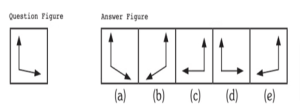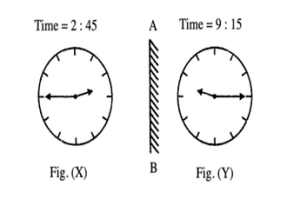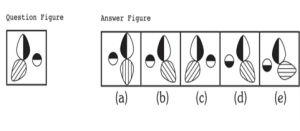Mirror images are the trickiest part of mental ability. They seem to be easy but are very confusing. The concept of mirror image questions identifies given images’ mirror reflections. The image appears exactly the reverse of the original image and is hard to identify without correct analysis. Identification of mirror images requires keen observation and analytical skills. In general, the mirror image of an object looks like the reverse of that image. The right of the original image forms the left of the mirror image and vice versa. A few key concepts can help us easily solve the mirror images. Let’s learn the methods of solving mirror image questions in this article.
A mirror image is an object’s image that is formed due to its reflection in a plane mirror. In simplified terms, a mirror image is an object’s reflection seen in the mirror. There are two types of mirror images: two dimensional and three-dimensional. Even letters’ mirror image identification questions are also asked in aptitude tests.
Mirror image questions
To understand the concept of mirror images, let’s see an example of a mirror image question and analyse it. There are mainly three types of questions in non-verbal reasoning on mirror images. They are image-oriented questions, number-oriented questions, and alphabet-oriented questions.
Question: image-oriented question
The questions on mirror images regarding images are easy to understand if they are analysed properly. The mirror image will be the opposite of the original image. The image and mirror image directions change depending on the mirror’s location. Understanding opaque images is easier than transparent images. The patterns must be analysed and identified properly to obtain the correct answer.
Select the option that resembles the provided combination’s mirror image
We place the mirror vertically on the question figure’s RHS. As a result, only figure (e) is the correct mirror image.

Question: image-oriented number
Questions regarding numbers are a little bit confusing. The reflection of a few numbers is quite different from their original form. The mirror image not only depends on the characters of the real image but also on the placement of the mirror. The mirror can be placed either horizontally or vertically. The mirror image is different in both cases.
Question
Select the option that resembles the provided combination’s mirror image
we place the mirror vertically on the question figure’s RHS. As a result, only figure (b) is the correct mirror image.
![]() Question: alphabet/number oriented
Question: alphabet/number oriented
The question based on letters of the alphabet in mirror imaging is easy. There are 26 letters, and they are different from one another. Few alphabets like A, H, I, M, O, T, U, V, W, X, and Y do not change from the original alphabet in a vertical mirror image for capital letters. The alphabets i, l, o, u, v, w, and x do not change from the original alphabet in a vertical mirror image for small alphabets. But for horizontally placed mirrors, the image is very different.
Question:
A mirror-reflected clock shows a quarter to three. What is the clock’s correct time?
- 8: 15
- 9: 12
- 8: 17
- 9: 15
Fig (X) shows that when viewed through a mirror, the clock shows 2.45. As shown in Fig. (Y), the mirror image shows the actual time on the clock is 9: 15.

Solving mirror image questions
Mirror image questions are quite interesting and confusing. Constant practice, observation, identification, and analysis are the key factors to solving these questions easily. If not understood correctly, these questions are often time-consuming and risky. While writing any competitive exam, time management is necessary to obtain a good score and complete all the questions properly. The mirror image questions are the most important part of the reasoning and mental ability section. If practised perfectly, these questions often save time during exams. To solve the mirror image questions, we need to understand the question thoroughly. The placement of the mirror, image, and given options are to be appropriately integrated. Only then can we solve the problem quickly.
- When the mirror is placed on the top or bottom of the image, the left and right remain unchanged, whereas the top and bottom change.
- If the mirror is placed vertically on the right side of the image, then the top and bottom of the image remain unchanged, whereas the left and right of the image interchange.
- If the mirror is placed vertically on the left side of the image, then the top and bottom remain unchanged, whereas the left and right of the image exchange.
Conclusion:
Practising mirror image questions increases critical analysis, problem-solving, and analytical skills. These form the most important part of non-verbal reasoning and mental ability concepts. These are unique and are creative. Reasoning is very important for every competitive and corporate exam. According to recent surveys, mirror image questions are one of the top-scoring concepts in the non-verbal reasoning part of exams and interviews. This becomes easy with constant practice and hard work. When the questions are asked only on images, letters, or numbers separately, they are easy to analyse. But, when the questions are asked using numbers and letters, it becomes a bit hard. We can solve these well through good analysis, identification, and observation.
 Profile
Profile Settings
Settings Refer your friends
Refer your friends Sign out
Sign out





 Question: alphabet/number oriented
Question: alphabet/number oriented